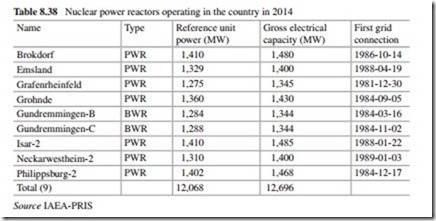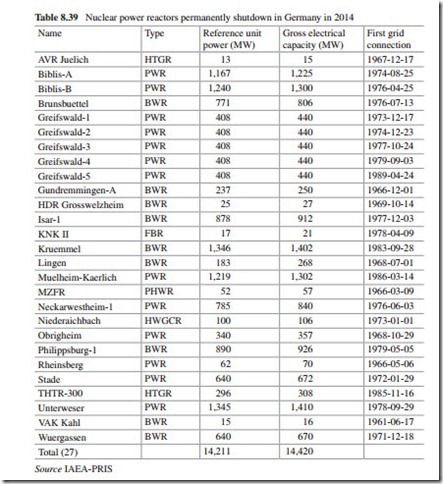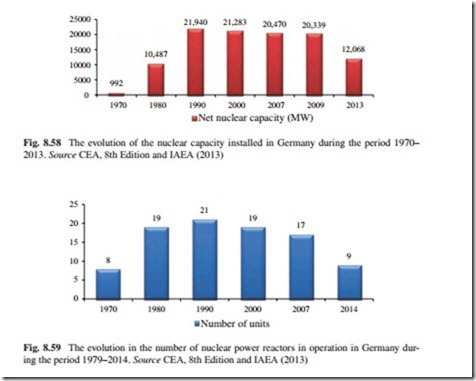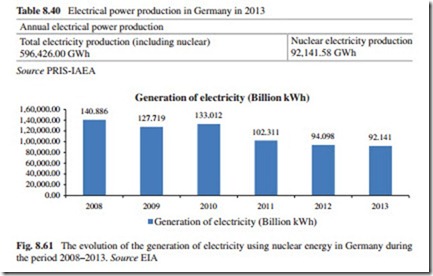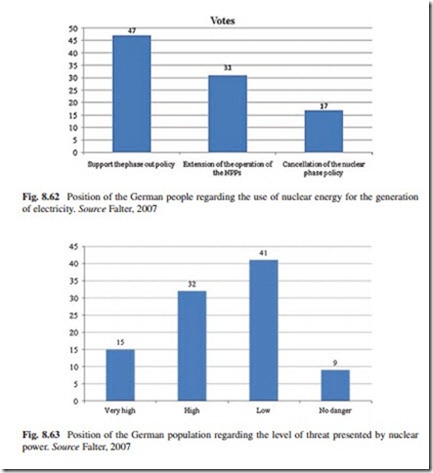Germany
Germany until March 2011 obtained 25 % of its electricity from nuclear energy, using 17 nuclear power reactors. In 2014, as a result of the negative impact of the Fukushima Daiichi nuclear accident in the country, the government shutdown eight nuclear power reactors. Today, Germany has nine nuclear power reactors in operation with a total capacity installed of 12,068 MW and supplied 15.45 % of the total electricity produced in the country in 2013, a reduction of 9.55 % with respect to 2011. The nuclear power reactors operating in the country in 2014 are included in Table 8.38.
Out of the total nuclear power reactors, two are BWR and seven PWR systems. After the Fukushima nuclear accident, the government took the decision to shutdown the remaining nine units currently in operation before 2022. The nuclear power reactors that are now in permanent shutdown in Germany are included in Table 8.39.
The total nuclear capacity withdrawn from the system was 14,211 MW.
After the reunification of Germany in 1990, all the Soviet-designed nuclear power reactors operating in the Eastern part of the country were shutdown for safety reasons and are being decommissioned. In general, 19 experimental and commercial nuclear power reactors have been shutdown and decommissioned in Germany until 2008.
The evolution of the nuclear capacity in the country since 1970 is shown in Fig. 8.58.
According to Fig. 8.58, the nuclear capacity in Germany during the period 1970–1990 increased significantly and the number of units augmented from 8 to 21 units. However, after 1990, the nuclear capacity installed in the country started to decrease. During the period 1990–2013, the nuclear capacity installed in Germany decreased 45 % and the number of units reduced from 21 to 9 units. It is expected that the nuclear capacity installed in the country after 2022 will be zero, because the government took the decision to shutdown all units before that year (see Fig. 8.59).
The location of the German nuclear power plants is shown in Fig. 8.60.
The Energy Policy in Germany
According to Morales Pedraza (2012), since the 1970s, a central focus of the West German government energy policy has been to shift electricity production away
from imported oil and gas toward coal and nuclear power, taking into account the important brown coal reserves that Germany has. During the period 1975–2003, the share of nuclear energy in the energy mix of the country has grown from 9 to 28 %. In 2006, the share of nuclear power was 20.6 %, a little bit lower than in 2003. In 2008, the nuclear share was 28.29 % and in 2013 that share decreased to 15.45 % producing 92,141.58 GWh. The decrease was 12.84 % with respect to 2008.
To reduce the dependency from coal and nuclear energy for the production of electricity, the German government adopted the following energy policy: All fed- eral governments should promote the utilization of all available renewable energy
sources. The utilities are required by law to buy electricity generated by independent producers using different types of renewable energy sources.
German support for nuclear energy was very strong in the 1970s following the oil price shock of 1974, and as in France, there was a perception of vulnerability regarding energy supplies. However, this policy faltered after the Chernobyl nuclear accident in 1986, and for this reason, the last new nuclear power plant was commissioned in 1989. Whereas the Social Democratic Party (SPD) had affirmed nuclear power in 1979, in August 1986 it passed a resolution to abandon nuclear power within ten years. The situation has become critical after the Fukushima Daiichi nuclear accident, forcing the government to shutdown eight units a few months after the accident and the abandon of the use of nuclear energy for the generation of electricity before 2022.
The most immediate effect of this change of policy was to terminate research and development on both the high-temperature gas-cooled reactor and the fast breeder reactors after some 30 years of promising work, since much of the work was in North Rhine-Westphalia, which was governed by the SPD. A Christian Democrat (CDU) federal government then maintained support for existing nuclear power generation nationally until defeated in 1998.
In October 1998, a coalition government was formed between the SPD and the Green Party, the latter having polled only 6.7 % of the vote. As a result, these two parties agreed to change the law to phase out of nuclear power. Long drawn-out “consensus talks” with the electric utilities were intended to establish a timetable for phase out, with the Greens threatening unilateral curtailment of licenses with- out compensation, if agreement was not reached.
In June 2000, a compromise was announced, which saved face for the government and secured the uninterrupted operation of the nuclear power plants for many years ahead. The agreement, while limiting plant lifetime to some degree, averted the risk of any enforced plant closures during the term of that government. In particular, the agreement puts a cap of 2,623 billion kWh on lifetime production by all 19 operating nuclear power reactors, equivalent to an average lifetime of 32 years (less than the 35 years sought by industry). Two key elements were a gov- ernment commitment to respect the rights of utilities to operate existing nuclear power plants, and a guarantee that this operation and related waste disposal will be protected from any politically motivated interference. Other elements included:
• A government commitment not to introduce any “one-sided” economic or taxation measures;
• A recognition by the government of the high safety standards of German nuclear power plants and a guarantee not to erode those standards;
• The resumption of spent fuel transports for reprocessing in France and UK for five years or until contracts expire;
• Maintenance of two waste repository projects (at Konrad and Gorleben).
In June 2001, the leaders of the SPD-Green coalition government and the four main energy companies signed an agreement to give effect to this 2000 compro- mise. The companies’ undertaking to limit the operational lives of the reactors to an average of 32 years meant that two of the least economic ones—Stade and Obrigheim—were shutdown in 2003 and 2005, respectively, and the one non-oper- ational reactor (Muelheim-Kaerlich with a capacity of 1,219 MWe) commenced decommissioning in 2003. It also prohibited the construction of new nuclear power plants for the time being and introduced the principle of on-site storage for spent fuel.
The new (CDU) and Liberal Democrat (FDP) coalition government elected in September 2009 was committed to rescinding the phase-out policy, but the finan- cial terms took a year to negotiate. If reactor lifetimes were extended from an average 32–60 years, the four operating companies would have reaped additional gross profit of €100 billion or more, and the government was keen to secure more than half of this—much more than its extra tax revenue.
In September 2010, a new agreement was reached, to give an eight year license extension (from 2001 agreed dates) for all nuclear power reactors built before 1980, and 14-year extension for later ones. The price exacted for this was several new measures: A tax of €145 per gram of fissile uranium or plutonium fuel for six years, yielding €2.3 billion per year (about €1.6 cents per kWh), payment of €300 million per year in 2011 and 2012, and €200 million 2013–16, to subsidize the use of renewable energy sources for the generation of electricity, and a tax of €0.9 cents per kWh for the same purpose after 2016. However, utilities could reduce their contribution to the use of renewable energy sources, if safety upgrades to particular individual nuclear power plants cost more than €500 mil- lion. At the end of October, these measures were confirmed by parliamentary vote on two amendments to Germany’s Atomic Energy Act, and this was confirmed in the Upper House in November 2010.
All these arrangements were thrown into doubt when in March 2011, after the Fukushima Daiichi nuclear accident, the government declared a three-month mor- atorium on nuclear power plants, in which checks would take place and nuclear policy would be reconsidered. Chancellor Angela Merkel decreed that the country’s nuclear power reactors, which began operation in 1980 or earlier, should be immediately shutdown. Those units were closed and were joined by another unit already in long-term shutdown, making a total of 8,336 MWe offline under government direction, about 6.4 % of the country’s generating capacity. It is important to highlight that his decision was not based on any safety assessment, but in political consideration.
In May 2011, the Reactor Safety Commission (RSK) reported that all German nuclear power reactors were basically sound and safe. It had reviewed all 17 units in operation and evaluated their robustness with respect to natural events affecting the plants, blackouts and failure of the cooling system, precautionary and emergency measures as well as man-made events affecting the plant, e.g., plane crashes.
However, despite this safety assurance, on May 30, 2011, after increasing pressure from antinuclear federal states, the government decided to revive the previous government’s phase-out plan and took the decision to close all nuclear power reactors by 2022, but without abolishing the fuel tax, thus reneging on the new fuel tax trade-off. The Bundestag passed the measures by 513–79 votes at the end of June, and the Bundesrat vote on 8 July confirmed this. Both houses of parliament approved construction of new coal and gas-fired plants despite claiming to retain its CO2 emission reduction targets, as well as expanding wind energy. This policy of replacing nuclear power with extra fossil fuel capacity and vastly expanding, highly subsidized renewables is known as the “Energiewende.”
On the based on this decision, the eight oldest nuclear power reactors were definitively closed and promised to result in the remaining nine closings by the end of 2022. All German nuclear operators have appealed to the justice to revoke the current government’s plan that forces them to stop all nuclear power plant operations before 2022.
Germany represents the largest economy to move away from nuclear energy as a result of the Fukushima Daiichi nuclear accident, but it is not the only one. Switzerland decided that nuclear energy will not be part of its energy future, and the country’s Federal Council authorized a gradual phase-out of all existing nuclear facilities before 2035.
Undoubtedly, the Fukushima Daiichi nuclear disaster created a strong antinuclear response from the Germans pushed the government to re-evaluate their decisions on the use of nuclear energy for the generation of electricity. The situation became so hot that an April election in Baden-Wuerttemberg largely became a referendum on nuclear power. As a result of their nuclear platform, the Greens party secured a record number of votes in the election, leading the Christian Democrats to lose governorship of the state for the first time in nearly 60 years.
Generation of Electricity Using Nuclear Energy
The total generation of electricity and the share of nuclear power in the energy mix of the country are shown in Table 8.40.
The evolution of the generation of electricity using nuclear energy in Germany during the period 2008–2013 is shown in Fig. 8.61.
According to Fig. 8.61, the generation of electricity in Germany during the period 2008–2013 decreased 34.6 %. It is expected that the generation of electric- ity using nuclear energy will continue decreasing until 2022, the year in which the government will shutdown all nuclear power reactors in operation.
The Public Opinion
It is important to highlight that German support for nuclear energy was very strong in the 1970s, following the oil price shock of 1974, due to their perception of the vulnerability of the country regarding energy supplies. The opposition to the use of nuclear energy for electricity production was not strong until early 1980s, but after the Chernobyl nuclear accident, the opposition to the use of this type of energy for the generation of electricity increases significantly. Due to this terrible nuclear accident, the political consensus on the use of nuclear energy for electricity generation was lost. Since 1986, the quite successful German nuclear power program faced a steadily increasing opposition. Many people were against the use of nuclear energy for electricity generation in the country. Violent demonstrations and occupation of
potential sites took place, mainly at Brokdorf, Wyhl, and Wackersdorf. Concerned citizens raised objections in the administrative courts. Consequently, construction and licensing of nuclear power plants were considerably delayed due to ongoing litigation. Today, in Germany, the construction of new nuclear power reactors for electricity generation is forbidden by law (Germany-IAEA country file 2004).
However, it is important to highlight that the German public sentiment in the last few years has swung strongly in support of nuclear energy again. A poll carried out late in 1997 showed that some 81 % of Germans wanted existing nuclear power reactors to continue operating, the highest level for many years and well up from the 1991 figure of 64 %. The vast majority of Germans expected nuclear energy to be widely used for the electricity generation in the foreseeable future. The poll also showed a sharp drop in sympathy for militant protests against the transport of radioactive waste. A major poll carried out after the October 1998 election confirmed German public support for nuclear energy. Overall, 77 % sup- ported the continued use of nuclear energy, while only 13 % favored the immediate closure of nuclear power plants (Germany-WANO 2008).
When the government announced, in 2000, that the country was phasing out its nuclear power plants, it seemed that decades of antinuclear activities in Germany could be laid to rest. Indeed, protests against nuclear power virtually disappeared from the calendars of political activists. However, a series of revelations about leaks at a nuclear waste dump combined with a fresh political debate about the nuclear phase-out policy has led to a revival of the movement. In December 2008, thousands of people turned out to disrupt the transport of radioactive nuclear waste from France to a dump in Germany. They were the biggest and most violent anti- nuclear protests in Germany since 2001, with activists setting fire to barricades and chaining themselves to train tracks. The protests delayed for hours the trans- port of the disputed nuclear waste to the long-term storage facility in Gorleben, located just Southeast of Hamburg. The organization campaigns for the speedy phase-out of the country’s remaining nuclear power plants. The opposition Greens and the far-Left Party had called on their members to join future protests. German papers see the protests as evidence that the old conflict over nuclear energy is far from over. The center-left Süddeutsche Zeitung writes: “In Gorleben it was much more than the repeat of a ritual. Mobilized by the Greens, many more peo- ple demonstrated this time. The non-violent blockades were carefully prepared and attracted many noticeably young demonstrators. In this way a movement that many believed was dead could be revived.”
Many young citizens now take for granted the nuclear power phase-out that was pushed through by the SPD and the Greens. Anyone who now uses the climate crisis to put it in question, and presents nuclear power as environmentally friendly energy, will not have any easy time of it—rather they will provoke the renaissance of an old conflict. The conservative Die Welt wrote: “For a time, it seemed that rising prices of oil and gas and greater dependence on energy exports from Russia allowed for a heretical idea: rethinking the nuclear phase-out. It would be good, if this debate were to continue. However, the final storage question remains vital, and even those in favor of nuclear power have to concede this. In a heavily populated country like Germany-one that may be technically accomplished, but also one which is notoriously fretful—this issue needs to be re-examined.” The left-leaning Die Tageszeitung wrote: “The unresolved question of nuclear waste disposal is once again at the forefront of people’s minds.”
In 2005, according to special Eurobarometer, around 59 % of the German people were against the use of nuclear energy for the generation of electricity and 38 % was in favor. In January 2007, the percentage of German people that was against the use of nuclear energy for the generation of electricity dropped to 47 %; around 31 % support that the nuclear power plants in operation continuing the sup- ply of electricity and 17 % were in favor to cancel the nuclear power phase-out policy. However, it is important to note that, in 2007, around 60 % of the German population did not favor of a phase-out without alternatives. In the Eastern part of the country, this percentage is almost 67 % (see Figs. 8.62 and 8.63).
After three decades of opposition, the number of Germans who support nuclear energy is creeping upward. According to surveys carried out by the Bielefeld- based Emnid Institute for both the atomic lobby Deutsches Atomforum and the antinuclear organization Greenpeace Germany, 48 % of Germans are in favor of extending the remaining running time of the country’s nuclear power plants, com- pared to 40 % two years ago.
In April 2009, a poll carried out by the Forsa Institute showed that 57 % of all Germans consider atomic energy “dangerous or very dangerous.” Of those aged 18–29, only 49 % are worried about the safety of nuclear power plants. Fears of a Chernobyl repeat have long dominated the nuclear debate in Germany, but Kemfert says “the generation that has no memories of that infamous accident sees things differently. Young people right now are pragmatic”, she says, “and they are more worried about climate change than anything else.”
Recent polls consistently show that a big majority of Germans want all nuclear power plants shutdown as soon as possible. The question is not whether to end the use of nuclear energy for the generation of electricity, but how satisfy electricity demands without the 92,141.58 GWh electricity generated by the nuclear power plants in 2013, bearing in mind the vast cost of gas-fired generators, wind turbines, solar plants, and a new power grid that Germany will soon build to replace the old system.
It is important to highlight that the four main power transmission companies have warned Berlin there could be blackouts if the nuclear plants close too soon, leaving the grid without reserves to cope with peaks of winter demand. The IEA warns also the German government that the adopted policy of shutting down all of its nuclear power plants may destabilize linked power grids throughout Europe. It is not German; it is a European problem, said Nobuo Tanaka, the veteran Japanese diplomat who is the IEA Executive Director.
Skeptics say Germany may simply end up importing nuclear-generating electricity from its neighbors, salving its own conscience while leaving them with all the disadvantages of the use nuclear energy for the generation of electric- ity. Generated and imported from two nuclear plants in Switzerland, for example, the electricity is not markedly cheaper than other options. But it is cleaner and safer, according to industry sources. Meanwhile, Germany’s Association for Environment and Nature condemned the offer as “immoral and scandalous”, arguing that national energy policy should aim instead to become more efficient to meet demand, rather than generating more.
But despite the legacy of the Fukushima Daiichi nuclear accident and those at Three Mile Island and Chernobyl, the German nuclear industry insists nuclear power is still the safer option. It also emphasizes the individual savings on emissions that nuclear power consumers can make, claiming it reduces their carbon footprint on average by two tons of emissions a year to 20 kilos.
However, this new enthusiasm for the nuclear supply does not denote a firm trend. Many customers make some savings by switching providers occasionally to benefit from newcomer offers.
And nuclear power providers in 2013 still saw their share of the German market fall from 17.6 to 15.4 %, while coal accounted for 45 % of German energy.
Germany last year burned 7 % more coal than in 2012, increasing its carbon dioxide emissions by 2 %, or by 20 million tons. This situation complicates ongoing efforts to reduce CO2 emissions in the country and worldwide. Germany aimed by 2020 to reduce its CO2 emissions by 40 % compared to 1990 levels, and by 80 % by 2050.
On the other hand, it is important to know that more than a third of Germany’s oil and gas come from Russia, as well as one-quarter of its coal now subject to economic sanctions for its role in the Ukrainian crisis. A quick restructuring to other sources such as liquefied gas imports from the USA is also not possible due to the infrastructure need.
Looking Forward
On the basis of the decision adopted by the German government to shutdown all nuclear power reactors still in operation before 2022, there is no future for the use of nuclear energy for the generation of electricity in the country beyond that year.
